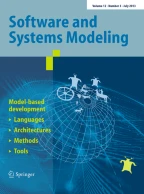Abstract
There seems to be a never ending stream of new process modeling notations. Some of these notations are foundational and have been around for decades (e.g., Petri nets). Other notations are vendor specific, incremental, or are only popular for a short while. Discussions on the various competing notations concealed the more important question “What makes a good process model?”. Fortunately, large scale experiences with process mining allow us to address this question. Process mining techniques can be used to extract knowledge from event data, discover models, align logs and models, measure conformance, diagnose bottlenecks, and predict future events. Today’s processes leave many trails in data bases, audit trails, message logs, transaction logs, etc. Therefore, it makes sense to relate these event data to process models independent of their particular notation. Process models discovered based on the actual behavior tend to be very different from the process models made by humans. Moreover, conformance checking techniques often reveal important deviations between models and reality. The lessons that can be learned from process mining shed a new light on process model quality. This paper discusses the role of process models and lists seven problems related to process modeling. Based on our experiences in over 100 process mining projects, we discuss these problems. Moreover, we show that these problems can be addressed by exposing process models and modelers to event data.
Similar content being viewed by others
References
van der Aalst, W.M.P.: TomTom for business process management (TomTom4BPM). In: van Eck, P., Gordijn, J., Wieringa, R. (eds.) Advanced Information Systems Engineering, Proceedings of the 21st International Conference on Advanced Information Systems Engineering (CAiSE’09). Lecture Notes in Computer Science, vol. 5565, pp. 2–5. Springer, Berlin (2009)
van der Aalst, W.M.P.: Business process simulation revisited. In: Barjis, J. (ed.) Enterprise and organizational modeling and simulation. Lecture Notes in Business information Processing, vol. 63, p. 14. Springer, Berlin (2010)
van der Aalst, W.M.P.: Process Mining: Discovery, Conformance and Enhancement of Business Processes. Springer, Berlin (2011)
van der Aalst, W.M.P., Adriansyah, A., van Dongen, B.: Replaying history on process models for conformance checking and performance analysis. WIREs Data Min. Knowl. Discov. 2(2), 182–192 (2012)
van der Aalst, W.M.P., Barthelmess, P., Ellis, C.A., Wainer, J.: Proclets: a framework for lightweight interacting workflow processes. Int. J. Coop. Inf. Syst. 10(4), 443–482 (2001)
van der Aalst, W.M.P., Nakatumba, J., Rozinat, A., Russell, N.: Business process simulation. In: vom Brocke, J., Rosemann, M. (eds.) Handbook on Business Process Management, International Handbooks on Information Systems, pp. 313–338. Springer, Berlin (2010)
van der Aalst, W.M.P., Reijers, H.A., Song, M.: Discovering social networks from event logs. Comput. Supported Coop. work 14(6), 549–593 (2005)
van der Aalst, W.M.P., Weijters, A.J.M.M., Maruster, L.: Workflow mining: discovering process models from event logs. IEEE Trans. Knowl. Data Eng. 16(9), 1128–1142 (2004)
ACSI. Artifact-Centric Service Interoperation (ACSI) Project Home Page. http://www.acsi-project.eu
Alves, A., Arkin, A., Askary, S., Barreto, C., Bloch, B., Curbera, F., Ford, M., Goland, Y., Guízar, A., Kartha, N., Liu, C.K., Khalaf, R., Koenig, D., Marin, M., Mehta, V., Thatte, S., Rijn, D., Yendluri, P., Yiu, A.: Web Services Business Process Execution Language Version 2.0 (OASIS Standard). WS-BPEL TC OASIS, http://docs.oasis-open.org/wsbpel/2.0/wsbpel-v2.0.html (2007)
Jagadeesh Chandra Bose, R.P., van der Aalst, W.M.P., Zliobaite, I., Pechenizkiy, M.: Handling concept drift in process mining. In: Mouratidis, H., Rolland, C. (eds.), International Conference on Advanced Information Systems Engineering (Caise 2011). Lecture Notes in Computer Science, vol. 6741, pp. 391–405. Springer, Berlin (2011)
Clarke, E.M., Grumberg, O., Peled, D.A.: Model Checking. The MIT Press, Cambridge (1999)
Harel, D., Marelly, R.: Come, Let’s Play: Scenario-Based Programming Using LSCs and the Play-Engine. Springer, Berlin (2003)
Herrmann, T., Hoffmann, M., Loser, K.U., Moysich, K.: Semistructured models are surprisingly useful for user-centered design. In: De Michelis, G., Giboin, A., Karsenty, L., Dieng, R. (eds.) Designing Cooperative Systems (Coop 2000), p. 174. IOS Press, Amsterdam (2000)
IEEE task force on process mining. Process mining manifesto. In: BPM Workshops. Lecture Notes in Business Information Processing. vol. 99, Springer, Berlin (2011)
Mendling, J., Verbeek, H.M.W., van Dongen, B.F., van der Aalst, W.M.P., Neumann, G.: Detection and Prediction of Errors in EPCs of the SAP Reference Model. Data Knowl. Eng. 64(1), 312–329 (2008)
Zur Muehlen, M., Recker, J.: How much language is enough? Theoretical and practical use of the business process modeling notation. In: Bellahsene, Z., Léonard, M. (eds.) Proceedings of the 20th International Conference on Advanced Information Systems Engineering (CAiSE’08), Lecture Notes in Computer Science, vol. 5074, pp. 465–479. Springer, Berlin (2008)
OMG. Business Process Model and Notation (BPMN). Object Management Group, formal/2011-01-03, 2011
La Rosa, M., ter Hofstede, A.H.M., Wohed, P., Reijers, H.A., Mendling, J., van der Aalst, W.M.P.: Managing process model complexity via concrete syntax modifications. IEEE Trans. Ind. Inf. 7(2), 255–265 (2011)
La Rosa, M., Wohed, P., Mendling, J., ter Hofstede, A.H.M., Reijers, H.A., van der Aalst, W.M.P.: Managing process model complexity via abstract syntax modifications. IEEE Trans. Ind. Inf. 7(4), 614–629 (2011)
Rozinat, A., van der Aalst, W.M.P.: Conformance checking of processes based on monitoring real behavior. Inf. Syst. 33(1), 64–95 (2008)
Song, M., van der Aalst, W.M.P.: Towards comprehensive support for organizational mining. Decis. Support Syst. 46(1), 300–317 (2008)
Witten, I.H., Frank, E.: Data Mining: Practical Machine Learning Tools and Techniques, 2nd edn. Morgan Kaufmann, San Fransisco (2005)
Yerkes, R.M., Dodson, J.D.: The relation of strength of stimulus to rapidity of habit-formation. J. Comp. Neurol. Psychol. 18, 459–482 (1908)
Acknowledgments
The author thanks all that contributed to development of ProM. The application of process mining to numerous real-life processes led to the insights reported in this paper.
Author information
Authors and Affiliations
Corresponding author
Additional information
Communicated by Prof. Jon Whittle and Prof. Gregor Engels.
Rights and permissions
About this article
Cite this article
van der Aalst, W.M.P. What makes a good process model?. Softw Syst Model 11, 557–569 (2012). https://doi.org/10.1007/s10270-012-0265-9
Received:
Revised:
Accepted:
Published:
Issue Date:
DOI: https://doi.org/10.1007/s10270-012-0265-9
